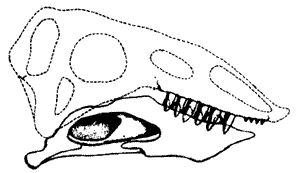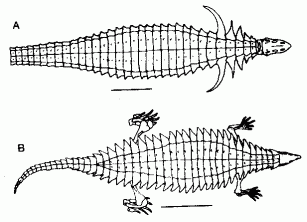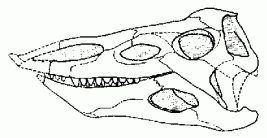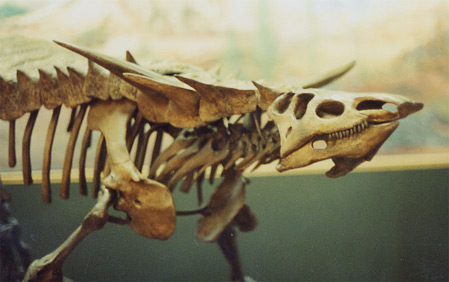
illustration in Bonaparte 1971, p.671.
| Archosauria | ||
| The Vertebrates | "Desmatosuchia" |
| Vertebrates Home | Vertebrate | Vertebrate |
|
Abbreviated Dendrogram
Archosauromorpha
│
└─Archosauria
├─Proterosuchidae
└─┬─Erythrosuchidae
└─┬─Euparkeriidae
└─Crown Group Archosauria
├─Ornithodira
│ ├─Pterosauria
│ └─Dinosauromorpha
└─Crurotarsi
├─Phytosauridae
└─Rauisuchiformes
├─Rauisuchia
│ ├─Ornithosuchidae
│ └─┬─Prestosuchidae
│ └─Rauisuchidae
└─Suchia
├─Aetosauridae
│ ├─"Stagonolepidinae"
│ └─"Desmatosuchia"
│ ├─Neoaetosauroides
│ └─"Desmatosuchinae"
│ ├─"Desmatosuchini"
│ │ ├─Longosuchus
│ │ └─┬─Desmatosuchus
│ │ └─Redondasuchus
│ └─"Typothoraxini"
│ ├─Typothorax
│ └─Paratypothorax
└─Crocodylomorpha
|
Contents
Overview |
(names of taxa in "inverted commas" are suggested here and have not been formally recognized)
"Desmatosuchia": Desmatosuchus > Stagonolepis
Phylogeny: "Stagonolepia" : Stagonolepidinae + * : Neoaetosauroides + "Desmatosuchinae"

|
| Neoaetosauroides engaeus, skull. illustration in Bonaparte 1971, p.671. |
Neoaetosauroides: Neoaetosauroides engaeus Bonaparte, 1967
Range: Latest Triassic (Coloradean) of South America (Argentina)
Phylogeny: "Desmatosuchia" : "Desmatosuchinae" + *.
Comment: Despite the name, this form does not appear to be very close to Aetosauroides (= Stagonolepis,). This relatively primitive aetosaur nevertheless lived right at the very end of the Triassic period, being one of the last of its kind. The following passage is from Jose Bonaparte's (1971) description:
This genus was published with preliminary descriptions. The type includes most of the articulated postcranium, with the jaws, but no trace of the skull. However, in another very incomplete specimen some diagnostic fragments of the skull are present. The jaw is short and rather heavy, with no teeth in site anterior region. The upper jaw bears 4 small "incisors" in the premaxilla, and robust maxillary teeth. It has no spikes or projections in the carapace. The tail is formed by 26 rows of osteoderms. It has been found in levels with melanorosaurids [prosauropod dinosaurs].
Links: UCMP Mystery Fossil Number 33; Introduction to the Aetosauria; Aetosauria Translation and Pronunciation Guide; JVP 22(3) September 2002—ABSTRACTS 31A DeSojo abstract) ATW030925.
References: Bonaparte (1971).
"Desmatosuchinae": Desmatosuchus and friends
Phylogeny: "Desmatosuchia" : Neoaetosauroides + * : "Desmatosuchini" + "Typothoraxini"
Comments: this is the second unnamed clade described in Parrish, 1994 (includes Longosuchus, Desmatosuchus, Typothorax, and Paratypothorax.). According to Harris et al 2003, Longosuchus and Desmatosuchus are more closely related than either is to Neoaetosauroides. This subfamily includes the most specialized and also many of the last surviving of the aetosaurs. Some forms have large backwardly curved spines, others very broad bodies and ovoid dorsal shields.

|
| Desmatosuchine aetosaurs of west equatorial Pangea, showing arrangement of armor. Desmatosuchus (top) and Longosuchus (bottom). Scale bar 50 cm. Illustration, from Murry 1986 p.180 |
"Desmatosuchini": Desmatosuchus and friends
Late Triassic (Early Tuvalian / Late Carnian to Rhaetian) of North America
Phylogeny: "Desmatosuchia" : "Typothoraxini" + * : Longosuchus + (Desmatosuchus + Redondasuchus)
Comments: Small to very large aetosaurs, often with backwardly curved spines. Unlike the Typothraxini, the body is narrow and crocodile-like. The phylogeny presented here is very tentative. It is proposed that the three genera represent an approximate evolutionary succession. This lineage appears to have been limited to equatorial west Pangea.

|
| Longosuchus meadei, top view, showing arrangement of armour illustration in Krebs 1976, p.81 after H.J. Sawin 1947 |

|
|
Longosuchus meadei, skull. illustration in Krebs 1976, p.79. |
Longosuchus meadei Hunt & Lucas, 1990 (= Typothorax meadei Sawin 1947= Lucasuchus Long & Murry 1995)
Late Triassic (Early Tuvalian / Late Carnian (Otischalkian)) of North America
"Desmatosuchini" : (Desmatosuchus + Redondasuchus) + *
Characters and comments: A large (almost 3 meters) form; dorsal armor consists of broad discoidal shield or carapace of armour plates ridged with spines, but lacking the huge shoulder spines of its later cousin Desmatosuchus. Head relatively small; orbits small; paramedian plates pyramid-shaped [ p.79] The limbs are quite gracile and the armour ornamentation is radiate [Murray 1986 p.123]. The In early books it is described under the name Typothorax (sometimes in inverted commas), however it is somewhat distinct from the type species Typothorax coccinarum Cope, 1892 and so was placed by Hunt and Lucas in a distinct genus. This is an Otischalkian index fossil.
References: Parrish, 1994

|
| Desmatosuchus haploceros, drawing of skeleton. Length of original 4 or 5 meters (image from Mt. Blanco fossil catalogue - original source unknown) |

|
| Desmatosuchus haploceros, photo of head and part of body. photo © Robert Gay |
Desmatosuchus: Desmatosuchus haploceros (Cope 1892) (= Acaenasuchus Long & Murry 1995 - juvenile [Heckert & Lucas, 1999])
Late Triassic (latest Carnian (Adamanian) to Early/Mid Norian) of North America
"Desmatosuchini" : Longosuchus + (Redondasuchus + *)
Characters: extremely large (up to 4 or 5 meters); back completely covered with dermal plates with a broad median paired series and a smaller lateral paired series; the latter plates coming to a prominent point; the first five rings covering the foremost ten vertebrae, each other ring covering one vertebra [Zittel, 1932]. cervical paramedian scutes elongate and rectangular with raised boss or bar, postcervical not as elongate and without anterior bar. Scute ornamentation consists of randomly placed pits and grooves with little if any radiate pattern [Murray 1986 p.122],
Comments: This enormous, narrow-bodied aetosaur possessed, in addition to the normal complement of armour plates, a pair of huge, backwardly turned shoulder horns, preceded by several pairs of smaller spikes on the side of the neck. This is the largest and most impressive of the aetosaurs, and hence there are a number of pages on the web dedicated to it (mostly with just a simple illustration and brief description).
References: see also Small 2002.
Links: Desmatosuchus (drawing, by Rob Gay); Desmatosuchus, an aetosaur (photo); Desmatosuchus (short text description); Desmatosuchus Desmatosuchus; Desmatosuchus - sketch; Dinowelt - Desmatosuchus; Dinosaurios, tutorial interactivo - Desmatosuchus.

|
| Redondasachus; from Lucas 1998. |
Late Triassic (Rhaetian (Apachean) of North America
"Desmatosuchini" :: Desmatosuchus + *.
Characters: medium sized (about 2 meters long); scutes with ventral keel.
"Typothoraxini": Typothorax and Paratypothorax
Late Triassic (Late Tuvalian/Late Carnian to Rhaetian) of North America & Europe.
Phylogeny: "Desmatosuchinae" : "Desmatosuchini" + *: Typothorax + Paratypothorax + *
Characters: large (length to 3 meters); ovoid/discoidal dorsal shield; strap-like paramedian scutes (high W:L (Width to Length) ratio) [Heckert et al 1999; Murray 1986 p.122], ornamented with deep pits
Comments: Advanced large aetosaurs; the broad bodies indicate a large gut and hence specialized adaptation to fermenting plant material
Paratypothorax: P. andressorum Long & Bellew, 1985 (= P. ornatus, P. andressi)
Late Triassic (latest Carnian (Adamanian) of North America (Dockum Fm); Early-Mid Norian of North America, Greenland, and Europe. (Stubensandstein); to Rhaetian (Upper Chinle / Apachean)) of North America
Phylogeny: "Typothoraxini" : Typothorax + *
Characters: flat and regularly pitted dermal scutes; ornamentation consists of "prominent grooves and ridges that radiate from posteromedially placed bosses. These large, posteriorly hooked eminences have sharp anterodorsal margins and concave posterior margins" Murray 1986 p.122
Comments: Advanced large (c. 3 meters) aetosaurs with a broad dorsal shield, the scutes marked by ridges and bumps. Scutes from the Stubensandstein of Heslach, Germany, were originally misidentified as belonging to the phytosaur Nicrosaurus kapffi [Murray 1986, Creisler, 1996]. During the Norian at least, this animal and Aetosaurus shared the same distribution. This species survived right up until the Rhaetian age (Apachean land fauna zone) [Heckert & Lucas, 1999]

|
| Typothorax paramedian plates, scale bar 3 cm from Lucas 1998. |
Typothorax: T. coccinarum Cope, 1892
Late Triassic (Early/Mid Norian (Revueltian) ) of North America
Phylogeny: "Typothoraxini" : Paratypothorax + *
Characters: Scutes with ventral keel
Comments: Advanced large broad-bodied aetosaurs. This is a Revueltian age index fossil.
checked ATW060119
Using this material. All material by ATW is public domain and may be freely used in any way (also any material jointly written by ATW and MAK). All material by MAK is licensed Creative Commons Attribution License Version 3.0, and may be freely used provided acknowedgement is given. All Wikipedia material is either Gnu Open Source or Creative Commons (see original Wikipedia page for details). Other graphics are copyright their respective owners